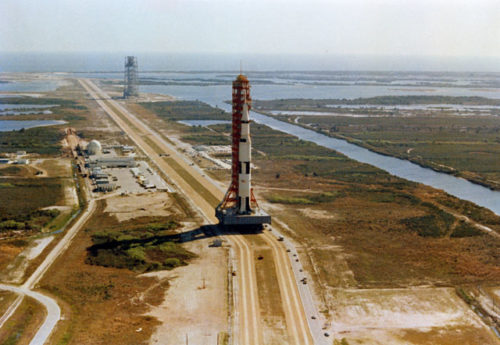
Apollo 10 rolls out in March 1969, becoming Pad 39B’s first occupant. Following the Apollo 10 launch in May 1969, four more Apollo missions would fly from Pad 39B, together with 53 Space Shuttle flights and most recently the Ares I-X test in October 2009. Photo Credit: NASA
For five decades, Pad 39B at the Kennedy Space Center (KSC) has served as the starting-point for some of the most pivotal missions in U.S. spaceflight history—from the launches of three Skylab crews and the astronauts of Apollo-Soyuz to more than 50 Space Shuttle flights and the first (and last) flight of the ill-fated Ares I-X—and now stands impatiently primed for the inaugural voyage of the Space Launch System (SLS), sometime after June 2020.
Fifty years ago, this spring, eleven millions pounds-worth (almost 5 million kilograms) of Saturn V booster rolled-out to the pad to become 39B’s first client. Apollo 10 would fly two months later, marking the first time that the new pad would be used to send humans to the Moon. That first rollout, all those years ago, would open the floodgates to a total of 59 launches from the Home Planet, including some of the most pivotal flights of exploration in NASA’s history.
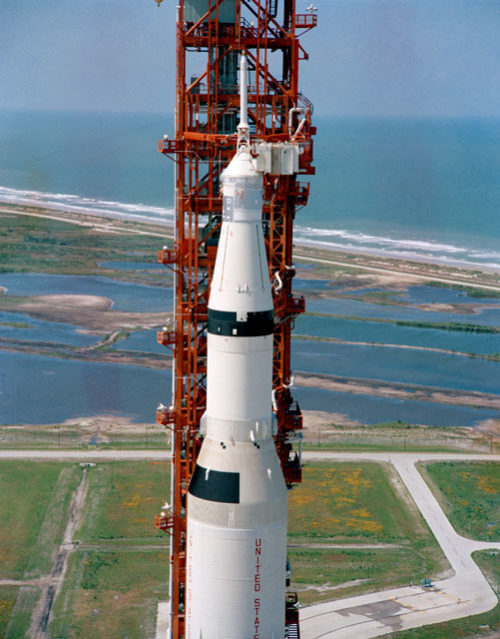
When Apollo 10 arrived at the launch pad, 50 years ago this month, Commander Tom Stafford noted that technicians we still putting finishing touches to the paint on the umbilical tower. Photo Credit: NASA
More than 36 stories tall, the Saturn V remains the largest and most powerful rocket ever brought to operational status and the sight of it rolling out of the cavernous Vehicle Assembly Building (VAB) on 11 March 1969 was a jaw-dropping spectacle for viewers at the Cape. Its destination, Pad 39B—resplendent in its freshly-painted “newness”—sat approximately 1.6 miles (2.6 km) north of Pad 39A. The latter had already earned itself a place in history as the launch site of the first Saturn V and the first human voyage to the Moon.
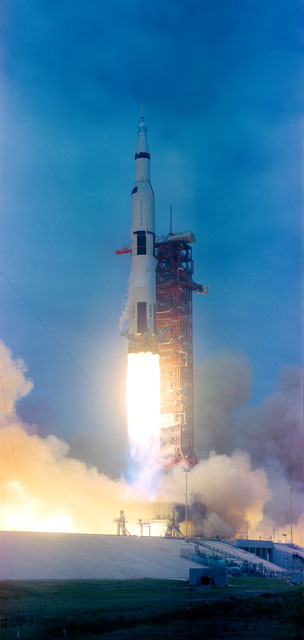
Pad 39B witnesses its first launch on 18 May 1969. Photo Credit: NASA
Roughly octagonal in shape, both Complex 39 pads were originally planned to form part of a wider network of up to five launch sites, spread along the marshy coastline of Florida’s Merritt Island. As early as 1963, blueprints called for the construction of 39A, 39B and 39C, running sequentially in a north-south line, with locations for 39D and 39E available for potential future development. However, 39A in its original guise was never built and the location for the “original” 39C wound up being redesignated “39A”. It was intended that 39A would be the primary base of operations for the Moon-bound Saturn V, although 39B would be kept in reserve, lest a launch disaster should wipe out its twin.
When Apollo 10 Commander Tom Stafford watched the fifth Saturn V—tail-numbered “505”—roll out to 39B, five decades ago, he could not help but think of the workers still putting finishing touches to the new complex. “NASA wanted to have two pads functioning in case of an accident,” Stafford later wrote in his memoir, We Have Capture, co-authored with spaceflight historian Michael Cassutt. “A new pad also meant a new firing room. So we faced several “firsts” on just the launch phase. That gave me some second thoughts, as I watched 505 being rolled out…knowing that workers were still rushing to finish the paint job on the umbilical tower.” Moving at a glacial pace of less than one mile per hour (1.6 km/h), the gigantic crawler transporter ferried the Saturn V along the 25,000 feet (7,600 meters) of crawlerway to Pad 39B.
Launched at 12:49 p.m. EDT on 18 May 1969, Apollo 10 marked the first of 59 missions to depart Pad 39B and still stands alone among them—for now, at least—in having sent a crew to the Moon. In May 1970, NASA announced that the pad would henceforth be modified for the Saturn IB booster, destined to ferry three crews to the Skylab space station. According to Skylab Program Director Bill Schneider, the decision to adopt Pad 39B over the originally-planned Pad 34 was made in order “to take advantage of the more modern facilities at the site and to save money by consolidating manpower and spacecraft support and checkout equipments and to reduce transportation costs”. It was noted that cost savings in the region of $10-12 million could be achieved by using Complex 39 for Skylab, as well as making full use of the processing facilities in the nearby VAB. Additionally, with Pad 34 having been exposed for several years to Florida’s salty air, it made more sense operationally to utilize Pad 39B.
One significant change for the Skylab flights was the addition of a 128-foot-tall (39-meter) pedestal—nicknamed “the milk-stool”—to raise the height of the smaller Saturn IB to access the upper-level swing-arms on the pad, which were designed for the much larger Saturn V. The milk-stool had originally been proposed by Boeing in February 1969 as a solution to the Saturn V-Saturn IB height differential and its design officially got underway in July 1970, after a lengthy series of pull tests, wind-tunnel simulations and dynamic and stress analyses. When fully assembled, it tapered from a 47.5-foot-diameter (14.5-meter) square at its base to a 22-foot-wide (6.7-meter) square at its apex. Capable of withstanding engine exhaust temperatures of 2,700 degrees Celsius (4,900 degrees Fahrenheit) and peak wind speeds of 37 mph (59 km/h), the milk-stool could more than prove its mettle under duress.
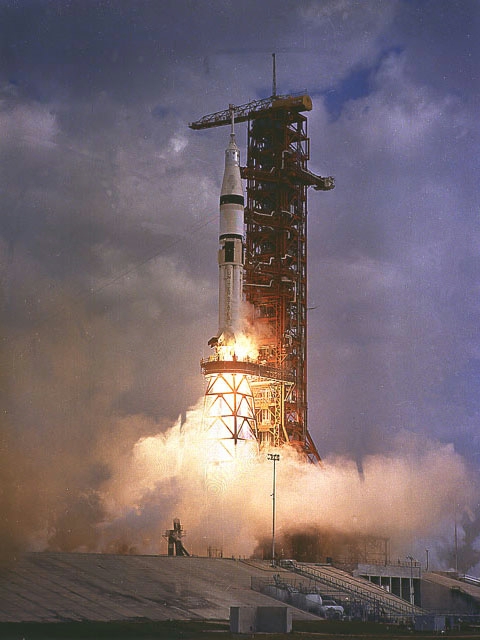
With a cry of “We can fix anything”, the first crew heads toward Skylab on 25 May 1973. Since the launch pad was originally configured for the enormous Saturn V rocket, the smaller Saturn IB required a ‘pedestal’ to raise its stages to the appropriate level for umbilicals and other utilities. Photo Credit: NASA
That duress was tested on four occasions between May 1973 and July 1975, when Pad 39B supported the three Skylab crews and the U.S. half of the Apollo-Soyuz Test Project (ASTP). Even before these missions were over, however, plans for its future role in the Space Shuttle Program had already begun. In September 1973, NASA announced its intent to redevelop Complex 39, whose twin pads of 39A and 39B had been specifically identified as having structures and facilities “readily adaptable” for reconfiguration to support the shuttle, its External Tank (ET) and twin Solid Rocket Boosters (SRBs).
More than a decade later, on 22 December 1985 shuttle Challenger was rolled-out to Pad 39B to begin final preparations for Mission 51L. Tragically, on 28 January of the following year, one of the worst and most public disasters ever witnessed by human eyes unfolded when Challenger and her crew were lost, just 73 seconds after liftoff. With her sister-pad, 39A, undergoing refurbishment, 39B would see service for the first seven post-51L missions, including the launches of NASA’s Magellan and Galileo spacecraft to Venus and Jupiter. Subsequent launches included STS-31 in April 1990, which delivered the showpiece Hubble Space Telescope (HST) to orbit, and STS-41 the following October, which lofted the Ulysses probe onto a multi-year trek to explore the Sun’s polar regions. Throughout the 1990s, Pad 39B was regularly used, seeing off the maiden voyage of Endeavour in May 1992, two HST servicing missions and the longest shuttle flight in history, STS-80 in the fall of 1996. Uniquely, the pad has borne silent witness to all three Return to Flight (RTF) missions: STS-26, in the wake of the Challenger tragedy, and the STS-114 and STS-121 test-flights after the loss of Columbia.
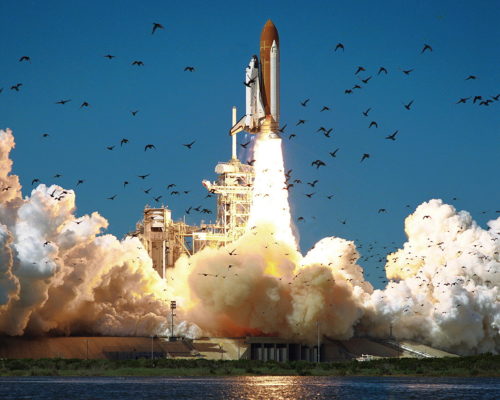
Flocks of terrified birds fly away in the face of Challenger’s roaring ascent from Pad 39B at 11:38 a.m. EST on 28 January 1986. Photo Credit: NASA
Following then-President George W. Bush’s declaration that the Constellation Program would return U.S. astronauts to the Moon and on to Mars, Pad 39B was selected to support the early flights of the Ares boosters. In December 2006, it supported its last scheduled shuttle launch—STS-116 to the International Space Station (ISS)—and was removed from service to commence refurbishment. In July 2007, NASA issued contracts for the fabrication of three 600-foot-tall (180-meter) towers, each one taller even than the VAB, as part of the lightning protection system for Ares launches.
But the shuttle program was not quite done with Pad 39B. Following NASA’s decision to fly a final HST servicing mission on STS-125, the agency required a “Launch-on-Need” (LON) shuttle to be kept on standby as a potential rescue vehicle. In September 2008, as Atlantis sat on Pad 39A, ready for her mission, sister Endeavour was rolled-out to 39B as her LON support vehicle. As circumstances transpired, STS-125 was delayed until May 2009 and Endeavour was transferred to Pad 39A to begin preparations for her own STS-126 mission. In April 2009 Endeavour returned to Pad 39B in readiness for her STS-125 LON support. And with Atlantis’ mission safely completed, on 31 May she was rolled-over to Pad 39A and the Space Shuttle Program (SSP) officially transferred responsibility for the 39B facilities over to the Constellation Program (CxP).
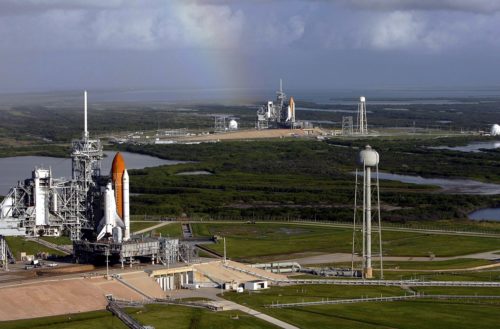
As Atlantis (foreground) sits on Pad 39A, awaiting her STS-125 mission to the Hubble Space Telescope (HST), her sister Endeavour resides in the background on Pad 39B. This was the last occasion that two shuttles occupied both pads simultaneously. Photo Credit: NASA
The old pad’s 59th launch—and her first without a crew aboard—was the Ares I-X test-flight in October 2009, envisaged as a barebones evaluation of a booster which was similar in size, shape and mass to the Ares I rocket, which was then under consideration to transport astronauts in the Orion spacecraft. In the months after the SSP/CxP transfer, Pad 39B had already changed markedly, gaining its three lightning towers, new access platforms and environmental control systems, a vehicle stabilization system and the removal of shuttle-era apparatus. On 20 October the 327-foot-tall (99.6-meter) Ares I-X was rolled-out to Pad 39B and, following a 24-hour weather-related scrub, successfully launched on the 28th. Powering away from Earth under 2.6 million pounds (1.2 million kg) of thrust, the Ares I-X achieved a peak altitude of 28.4 miles (45.7 km).
Yet Ares I-X would be the first, and last, launch of its type. In April 2010, then-President Barack Obama unveiled an entirely new architecture for deep-space human exploration, which crystallized in summer 2011 with the decision to develop the gargantuan Space Launch System (SLS). In November of that year, the 355-foot-tall (108-meter) Mobile Transporter (MT) for the new rocket was moved to Pad 39B for structural and functional engineering tests. In June 2014, NASA issued contracts to refurbish the pad’s environmental control system, and a year later upgrades got underway on the flame trench and the construction of a new flame deflector system.
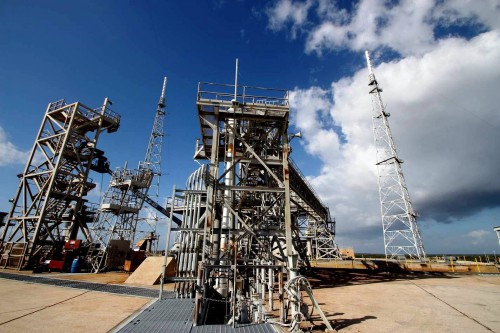
Launch Complex 39B has been renovated in the “clean” pad design, leaving very little to the eye. The one, obvious exception to this is the three 600 foot-tall lightning towers that rise majestically into the Florida sky. Photo Credit: Alan Walters / awaltersphoto.com
The guiding principle for the up-and-coming Pad 39B of the future was to turn it into a “clean pad”, capable of supporting a variety of launch vehicles. “The basics that every rocket needs will remain in place, such as electrical power, a water system, flame trench and safe launch area,” NASA noted. “The other needs of individual rockets, including access for workers, can be met with the towers or other structures that deliver the rocket to the pad.” During this process of readying Pad 39B for its next phase of activity, some 1.3 million feet (400,000 meters) of copper cables were replaced with 300,000 feet (90,000 meters) of fiber cable. The new flame trench, which measures 450 feet (135 meters) in length, comprises 96,000 bricks within its walls and the flame deflector itself incorporates 150 steel plates, each weighing around 4,000 pounds (1,800 kg).
To date, 59 missions have roared away from Pad 39B, counting from Apollo 10 in May 1969, through Skylab and ASTP, spanning 53 missions of the Space Shuttle era and the first—and last—voyage of an Ares I vehicle. Although recent developments suggest that the SLS may experience further delay beyond its current June 2020 target date to launch Exploration Mission (EM)-1 of the Orion spacecraft from Pad 39B, the future remains bright for Pad 39B and it can be confidently expected that the old site’s 60th launch may repeat (albeit without crew) the accomplishment of Apollo 10, all those years ago, by returning a human-capable vehicle to the vicinity of the Moon and safely home.
.
.
FOLLOW AmericaSpace on Facebook and Twitter!
.
.




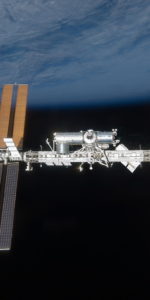
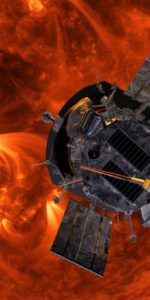
Here’s a look at the infrastructure upgrades to Pad 39B for SLS.
http://nasatech.net/ntSubPad39B_PAGE.html
How was the Saturn 1B placed atop the milk stool and how was it fueled?